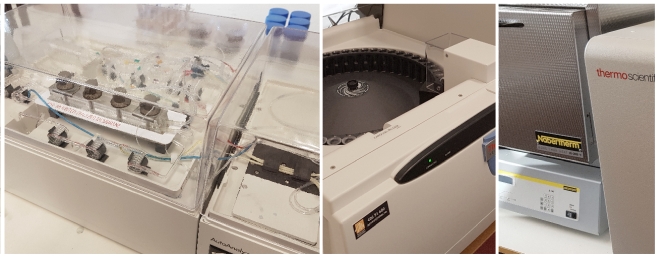Booking and prices
Prices: Contact Facility Manager
Booking: Contact Facility Manager
Contact information:
Facility Manager: Mufak Said Naoroz
Location: Sem Sælands vei 1
0371 OSLO
Norway
Instruments:
- Dionex ICS-1000 and ICS-2000 Ion Chromatography, for analysng anions and cations in aqueous samples.
-
Organic Elemental Analyzer (OEA) FisherSmart, for analysing of C, H, N, S and O in sediments and aqueous samples.
-
AutoAnalyzer 3 for measuring PO4 and SiO2 in aqueous samples.
- For analysis of the grain-size distribution and other physical properites of sediments and sedimentary rocks.
- Beckman Coulter, LS 13 320 − Laser Diffraction Particle Analyzer, Single Wavelength with Aqueous Liquid Module (ALM), (installed 2011)
- CHRIST, freeze driers
- Sieving shaker
The lab has instruments for basic measurements like pH, Conductivity, Alkalinity etc. and has equipment for routine preparation of samples.
Description of services:
- Analysis of ions, major and trace element compositions in water samples.
-
Analysis of the content of main organic elements in sediments and water samples
-
Analysis of the grain-size distribution and other physical properites of sediments and sedimentary rocks.
Aqueous Chemistry; How do we work?
We use the ion chromatography method to analyse main anions: bromide, fluoride, phosphate, chloride, nitrite, nitrate and sulphate and main cations; Na, K, Mg and Ca in all kinds of water.

The method is based on chromatographic separation (ion exchange) and further conductivity detection of separated ions.
Analysing of carbon (TOC and TC), hydrogen, nitrogen, sulphur and oxygen in our FisherSmart instrument is based on the flash dynamic combustion method, which produces complete combustion of the sample within high temperature reactors. After the gas separation in a chromatography column, a highly sensitive thermal conductivity detector (TCD) determines the elemental gasses produced.
In this lab everything from water to solids for instance samples of clay or other deposits or sediments, may be analysed.
Analysis of grain-size distribution
Grain-size distribution is used to describe and classify sediments, and it is important for understanding depositional processes, to predict the waterflow energy in aquatic environments, and for determining the permeability in sediments and soils.
In our laboratory we use wet or dry sieving (weight percentage for grain size >63 µm) and Laser Diffraction Particle Size Analysis (LPS),(volume percentage for grain size 0,4-2000 µm). The Beckman Coulter LS 13 320, measures the size distribution of particles suspended either in a liquid or in dry powder form by using the principles of light scattering.
The scattering pattern of light scattered by the particles in the sample is formed by light intensity as a function of scattering angle. Each particle's scattering pattern is characteristic of its size. The pattern measured by the LS 13 320 is the sum of the patterns scattered by each constituent particle in the sample.
The laboratory can by appointment be used for research activities and/or to assist students at the Department of Geosciences.
